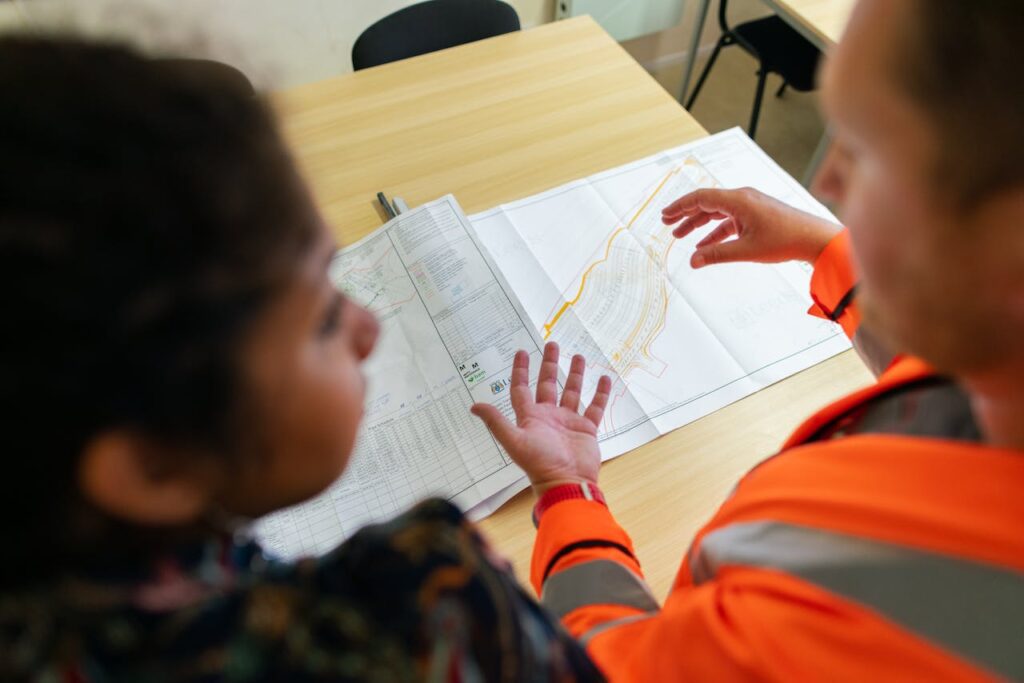Did you know that a staggering 80% of construction projects experience delays due to unforeseen risks, including human error, during the pre-construction phase? Effective risk management strategies, including safety and contingencies, play a pivotal role in mitigating these challenges and ensuring project success.
From identifying potential hazards to developing contingency plans, implementing robust risk management practices early on can save both time and resources down the line. Join us as we uncover key insights and practical tips to enhance safety, productivity, and risk management in your pre-construction planning process.
Understanding Construction Risk Management
Importance Of Construction Risk Management
Construction risk management involves identifying safety and addressing potential risks before they impact a project. This proactive approach is essential for minimizing delays, cost overruns, and other negative consequences that can arise during construction projects. By implementing effective risk management strategies early on, project teams can better navigate uncertainties, ensure successful outcomes, and save time.
Effective risk management helps in identifying possible challenges like adverse weather conditions or material shortages that could delay the project and impact productivity, time, and plan. It also assists in anticipating budget overruns due to unforeseen circumstances such as design changes or regulatory issues. Understanding these risks allows project managers to develop contingency plans and allocate resources efficiently to mitigate their impact.
Key Principles Of Construction Risk Management
The key principles of construction risk management revolve around proactive planning, thorough assessment, and continuous monitoring throughout the project lifecycle. Proactive planning involves anticipating potential risks based on past experiences or industry knowledge to develop mitigation strategies beforehand. Thorough assessment entails conducting comprehensive risk assessments at various stages of the project to identify new risks and reassess existing ones continually.
Continuous monitoring ensures that identified risks are actively tracked throughout the construction process to address any emerging threats promptly. Regular reviews help project teams plan and adapt their risk management strategies as needed based on changing circumstances or new information. By adhering to these key principles and having a solid plan, construction projects can maintain control over potential risks, enhance overall project success rates, and save time.
Identifying And Prioritizing Risks In Construction Projects
Analyzing Risks
Identifying project risk is crucial in pre-construction planning. This involves scrutinizing all aspects of a project, from design to execution, to pinpoint potential threats like budget overruns or material shortages. By thoroughly analyzing risks, the project team can anticipate challenges, help develop effective strategies to mitigate them before they escalate.
Taking a systematic approach and plan ensures that no significant risks are overlooked. For instance, examining past projects can reveal common issues such as delays due to permit acquisition or unexpected site conditions. By learning from previous experiences, the project manager can proactively address these recurring risks early in the planning phase.
Prioritizing Critical Risks
Once risks are identified, prioritization is key. Focusing on addressing critical and impactful risks first allows the team to allocate resources efficiently and minimize potential disruptions during construction. For example, if a project faces a tight deadline due to upcoming bids for future projects, addressing this time-sensitive risk promptly becomes paramount.
Assigning a risk owner within the project team ensures accountability for managing specific risks effectively. This individual takes responsibility for monitoring assigned risks throughout the project lifecycle and implementing mitigation measures as needed.
Types Of Risks In Pre-Construction Planning
Various Types Of Risks
Pre-construction planning involves potential risks such as design errors, regulatory compliance issues, and site-specific challenges. Design errors can lead to costly rework if not identified early. Regulatory compliance issues may cause delays or fines if not addressed promptly. Site-specific challenges like difficult terrain or environmental concerns can impact project timelines and costs significantly.
Financial risks are also prevalent during the pre-construction phase. Budget overruns can occur due to inaccurate cost estimations or unforeseen expenses. Changes in market conditions, such as fluctuations in material prices or labor shortages, can further escalate financial risks for construction projects.
Importance Of Understanding Risks
Understanding the specific types of risks in pre-construction planning is crucial for project teams to develop effective risk management strategies. By identifying potential risks early on, project managers can proactively mitigate them before they escalate into larger issues that could jeopardize the entire project timeline and budget.
Developing targeted risk management strategies tailored to the unique challenges of each construction project enhances overall project success rates by minimizing disruptions and unexpected costs along the way.
Techniques For Pre-construction Risk Assessment
Identifying Potential Risks
Risk assessment techniques play a crucial role in pre-construction planning by helping to pinpoint possible risks and their impacts. SWOT analysis is one such technique that aids in identifying strengths, weaknesses, opportunities, and threats related to a construction project. Through brainstorming sessions, project teams can gather diverse perspectives to uncover potential risks that might not have been initially apparent.
Quantitative methods are also essential in assessing risks effectively. Monte Carlo simulation, a quantitative risk analysis technique, allows project managers to evaluate the probability and severity of various risks accurately. By utilizing this method, construction teams can simulate different scenarios based on input variables to determine the likelihood of specific outcomes occurring during the project lifecycle.
Comprehensive Risk Understanding
To gain a holistic view of the risks involved in pre-construction planning, it is beneficial to combine both qualitative and quantitative risk assessment techniques. Qualitative methods focus on descriptive characteristics of risks without numerical measurements; meanwhile, quantitative approaches involve numerical data for precise risk evaluation. By merging these two methodologies, construction professionals can develop a comprehensive understanding of potential threats and their potential impacts on the project.
Pros:
- Helps identify diverse types of risks.
- Enables thorough evaluation through multiple perspectives.
- Facilitates accurate prediction of risk probabilities.
Cons:
- Requires time and resources for detailed assessments.
- May be challenging to quantify certain qualitative aspects.
Elements Of A Construction Risk Management Plan
Clear Objectives
A construction risk management plan is crucial in pre-construction planning. It sets clear objectives to identify, assess, and mitigate risks before they impact the project. By defining these objectives early on, construction teams can focus their efforts on addressing potential issues effectively.
Having specific objectives helps in prioritizing risks based on their potential impact and likelihood of occurrence. For instance, an objective could be to reduce schedule delays caused by unforeseen weather conditions or material shortages.
Roles And Responsibilities
Another essential component of a risk management plan is outlining roles and responsibilities within the team. Clearly defining who is responsible for identifying risks, implementing mitigation measures, and monitoring progress ensures accountability throughout the project lifecycle.
Assigning roles such as risk manager, project manager, safety officer, or quality control supervisor clarifies expectations and streamlines communication channels. Each team member understands their part in managing risks proactively to avoid costly setbacks down the line.
Timeline For Risk Mitigation Activities
Incorporating a timeline for risk mitigation activities into the plan ensures that tasks are completed promptly to address potential threats efficiently. Setting deadlines for risk assessments, implementing mitigation strategies, and reviewing outcomes creates a sense of urgency in dealing with identified risks.
Strategies For Managing Risks In Pre-Construction Phase
Developing A Risk Register
A risk register is a vital tool that project teams use to keep track of identified risks during the pre-construction phase. It helps in documenting potential risks, their likelihood, and impact on the project. By maintaining a risk register, teams can proactively address these risks before they escalate into larger issues. For example, if there is a risk related to unfavorable weather conditions delaying construction progress, it can be noted in the register along with planned mitigation strategies.
Creating a risk register involves listing all possible risks that could affect the project timeline or budget negatively. Each risk should be assessed for its probability of occurrence and potential consequences if it materializes. This process enables project managers to prioritize which risks need immediate attention and develop appropriate responses accordingly.
Implementing Risk Mitigation Strategies
Implementing risk mitigation strategies plays a crucial role in reducing the chances of identified risks impacting the construction project adversely. One effective strategy is conducting thorough feasibility studies before commencing any work on-site. These studies help identify potential challenges early on, allowing teams to plan and allocate resources more effectively. Another essential approach is engaging experienced consultants who can provide valuable insights based on their expertise.
Engaging in risk mitigation strategies ensures that projects are better prepared to handle unforeseen circumstances that may arise during pre-construction planning. By addressing potential risks head-on through various proactive measures like site inspections or soil testing, construction teams can minimize delays and cost overruns significantly.
Regular Review And Update Of Risk Management Strategies
Regularly reviewing and updating risk management strategies is essential to ensure they remain relevant and effective throughout the pre-construction phase. As projects progress, new risks may emerge or existing ones may evolve, requiring adjustments to mitigation plans accordingly. This ongoing review process allows project teams to stay ahead of potential issues by adapting their strategies promptly.
Utilizing Technology To Reduce Construction Risks
Building Information Modeling (BIM) Technology
Building Information Modeling (BIM) technology is a crucial tool in pre-construction planning. It enhances visualization and coordination, reducing design errors and clashes. By using BIM, project teams can create detailed 3D models that help identify potential issues before construction begins. This technology allows for better communication among team members, leading to improved decision-making and risk mitigation strategies.
Implementing BIM ensures that all stakeholders have access to accurate information throughout the project lifecycle. For example, if changes are made in the design phase, they automatically reflect across all related documents and plans. This level of integration helps prevent costly mistakes during construction by addressing conflicts early on.
Pros:
- Enhanced visualization
- Improved coordination
- Early issue identification
Cons:
- Initial investment may be high
- Training required for effective implementation
Risk Assessment Software Tools
Risk assessment software tools play a vital role in automating the process of identifying, evaluating, and prioritizing risks in construction projects. These tools enable project managers to systematically assess potential risks based on various factors such as probability and impact. By utilizing such software solutions, project teams can develop comprehensive risk management strategies tailored to specific project requirements.
The use of risk assessment software not only saves time but also improves the accuracy of risk evaluations. For instance, these tools provide quantitative data that aid in prioritizing risks based on their potential impact on the project timeline or budget constraints.
- Identify key risks through software analysis.
- Evaluate each risk’s probability and impact.
- Prioritize risks based on severity levels.
- Develop mitigation strategies accordingly.
Implementing Effective Response Plans For Construction Risks
Defining Specific Actions
Developing response plans is crucial. These plans outline specific actions that need to be taken if risks materialize. For example, if there’s a risk of material shortages, the action might involve identifying alternative suppliers or adjusting the construction schedule.
Creating a detailed plan with assigned responsibilities ensures that everyone knows what to do when faced with a risk. By defining timelines for implementing these actions, construction teams can effectively address issues as they arise, minimizing potential disruptions and delays.
Clear Communication Channels
Establishing clear communication channels is vital in ensuring that responses to risks are prompt and effective. Imagine a scenario where unexpected weather conditions threaten to cause delays in the construction schedule; having open lines of communication allows stakeholders to quickly assess the situation and make informed decisions on how best to proceed.
Moreover, setting up escalation procedures helps streamline decision-making processes during emergencies. If an unforeseen challenge arises that requires immediate attention, knowing who has the authority to make critical decisions can prevent confusion and ensure swift action is taken.
Validation Through Drills
Regular drills and simulations play a key role in validating response plans. By conducting these exercises periodically, project teams can identify any gaps or weaknesses in their strategies before actual risks occur. This proactive approach enhances team preparedness by familiarizing them with various scenarios they may encounter during construction.
Engaging in simulated situations such as labor strikes or equipment failures allows team members to practice executing their roles under pressure. Through these exercises, individuals gain confidence in their abilities to respond effectively when faced with real-world challenges on-site.
Revisiting And Revising Risk Management Plans
Identifying Gaps And Changes
Regularly reviewing risk management plans is crucial in pre-construction planning. It enables project teams to spot any gaps or shifts in the project’s risk profile. For instance, if a new regulation impacts the construction industry, revisiting the risk plan can ensure compliance and prevent costly delays.
Reviewing past projects’ management plans provides valuable insights into what worked well and what didn’t. By learning from previous experiences, teams can enhance their future risk management program efforts. For example, if poor weather conditions caused delays before, including additional contingencies for adverse weather situations in the revised plan can mitigate such risks.
Improving Future Mitigation Efforts
Making adjustments based on lessons learned from past projects ensures that future endeavors are better equipped to handle potential risks effectively. Enhancing management practices, such as updating communication procedures or adjusting decision-making processes, strengthens the overall ability to manage risks proactively.
Continuous improvement of contingency plans enhances project performance by reducing disruptions during construction activities. Implementing more robust contingency measures based on real-world scenarios encountered previously helps safeguard against unexpected events like material shortages or labor strikes.
You’ve now grasped the essence of construction risk management in pre-construction planning. By identifying risks, utilizing technology, and implementing effective response plans, you’re well-equipped to navigate the uncertainties that may arise. Remember, a solid risk management plan isn’t just a safety net; it’s your shield against potential setbacks and your key to project success. So, embrace these strategies, tailor them to your projects, and watch how they fortify your construction endeavors.
Take charge of your construction projects with proactive risk management. Dive into each phase armed with knowledge and preparedness. Your projects will thank you for the foresight and meticulous planning. Now, go forth and build with confidence!
Frequently Asked Questions
1. How Important Is Understanding Construction Risk Management In Pre-Construction Planning?
Understanding construction risk management in pre-construction planning is crucial as it helps identify potential risks early on, allowing for proactive measures to mitigate these risks and ensure a smoother project execution.
2. What Are The Key Elements Of A Construction Risk Management Plan?
A construction risk management plan typically includes risk identification, assessment, prioritization, response strategies, monitoring mechanisms, and regular reviews. These elements work together to create a comprehensive framework for managing risks effectively throughout the project lifecycle.
3. How Can Technology Be Utilized To Reduce Construction Risks In The Pre-Construction Phase?
Technology tools such as Building Information Modeling (BIM), drones for site surveys, real-time project tracking software, and virtual reality simulations can enhance risk assessment accuracy and provide valuable insights for preemptive risk mitigation strategies during pre-construction planning.
4. Why Is It Essential To Revisit And Revise Risk Management Plans During The Construction Process?
Revisiting and revising risk management plans are vital because new risks may emerge as the project progresses. By regularly reviewing and updating the plan based on evolving circumstances, teams can adapt quickly to changing conditions and maintain effective control over potential threats.
5. What Techniques Can Be Employed For Effective Response Planning When Dealing With Construction Risks?
Effective response planning involves developing contingency plans tailored to specific identified risks. Techniques like establishing clear communication channels, defining roles/responsibilities within the team, setting up emergency protocols, and conducting regular drills/tests can help ensure swift responses to mitigate adverse impacts of unforeseen events.
Optimize Your Project’s Success With Pre-Construction Planning By Red White & Blue Construction!
Embarking on a construction project in Lafayette, CA? Look no further than Red White & Blue Construction for expert pre-construction planning services! Specializing in laying the groundwork for successful construction projects, we tailor our pre-construction strategies to meet your specific project goals. Renowned for our expertise in pre-construction planning, we are committed to ensuring your project’s vision is meticulously planned and prepared for, whether it’s a residential, commercial, or community initiative. Our reputation across the Bay Area speaks to our dedication to precision, quality, and the exceptional standards we uphold in every phase of planning.
At Red White & Blue Construction, we do more than just prepare; we set the foundation for your project’s success. With our comprehensive planning, transparent pricing, and exceptional client service, you’re not just planning a construction project; you’re setting the stage for a seamless, efficient build. Choose Red White & Blue Construction for your pre-construction planning needs. Begin your project with confidence and contact us today!
Disclaimer
The materials available on this website are for informational and entertainment purposes only and not to provide advice. You should obtain advice concerning any particular issue or problem from a professional. You should not act or refrain from acting based on any content included in this site without seeking legal or other professional advice. The information presented on this website may not reflect the most current building developments. No action should be taken in reliance on the information on this website. We disclaim all liability concerning actions taken or not taken based on any or all of the contents of this site to the fullest extent permitted by law.





